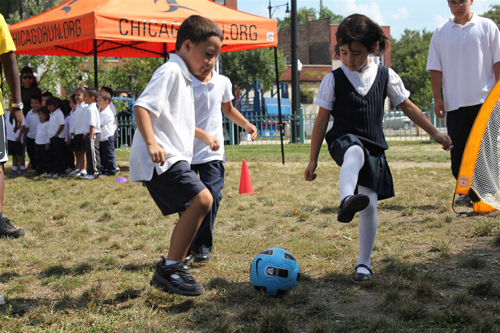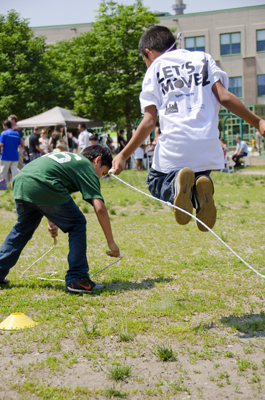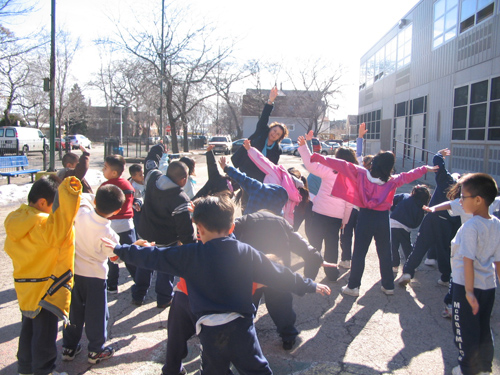
Inattention and hyperactivity is one of the most common types of mental and behavioral health problems that affects youth, according to Dr. Charles Basch, author of Healthier Students Are Better Learners. In Basch’s study, a synthesis of current research, he notes that approximately 4.6 million (8.4 percent) of American youth aged 6 – 17 have been diagnosed with ADHD (Attention Deficit/Hyperactivity Disorder), and that the problem disproportionately affects urban minority youth from poor families who may not only be more likely to be affected but also less likely to receive accurate diagnosis and treatment. For Health and Education Part 2, I asked experts in the field of ADHD, Dr. Gregory Fabiano, Dr. George DuPaul and Dr. Thomas Power, to share their perspectives on how the ADHD problem is impacting our domestic achievement gap and on the ways it is being addressed.
Dr. Thomas Power is the Director for Management of ADHD and Chief Psychologist, Department of Child and Adolescent Psychiatry and Behavioral Sciences at The Children’s Hospital of Philadelphia. Dr. Power has conducted research on children with ADHD for over 25 years and has published extensively on interventions for ADHD and community-based prevention. Dr. George DuPaul is Professor of School Psychology and Chair of the Department of Education and Human Services at Lehigh University. He has published extensively on assessment and treatment of ADHD and is the co-author of ADHD in the Schools: Assessment and Intervention Strategies. Dr. Gregory Fabiano is Associate Professor of Counseling, School and Educational Psychology in the Graduate School of Education at the University of Buffalo. He is extensively published in the field of ADHD and his particular area of interest is evidence-based assessments and treatments for children with ADHD.

Have the consequences of ADHD, treated and untreated, been quantified with regard to academic achievement compared with youth who do not have this disorder? What is the “gap”?
George: The gap has been quantified and it is somewhere between .75 to 1.0 standard deviations. This is considered a large difference that means that the average student with ADHD would score at about the 16th percentile relative to his or her non-ADHD peers.
Greg: In almost every area of functioning within schools, youth with ADHD fare poorer on achievement. Interestingly, children with ADHD are typically comparable on estimates of IQ and cognitive abilities, suggesting that their disorder is what is getting in the way of learning. For instance, some children with ADHD fail classes, not because they are having trouble learning the material, but because homework assignments are missing or incomplete, careless mistakes are made on quizzes, or they forget to turn in long-term projects.
Thomas: It is clear that the presence of ADHD greatly increases the risk of children with ADHD for academic problems, including grade retention, placement into special education, and early school dropout. Behavioral and academic interventions for children with ADHD improve academic performance. Also, medication reduces ADHD symptoms in school and related academic problems, such as poor work productivity and disorganization. In general, research supports the use of combined approaches to treatment (i.e., combination of behavioral and academic interventions with medication) to improve academic performance.

Does the multi-media environment that surrounds youth today foster ADHD symptoms?
Greg: Probably not. ADHD can be thought of as a selective attention deficit disorder and many children do not have difficulty interfacing with multi-media. The problems are apparent in situations where the child needs to sustain and focus mental effort. I would suggest that the current educational system fosters ADHD symptoms – if one wanted to exacerbate the symptoms of ADHD, the best way to do it would be to step up academic demands in an overcrowded classroom with extended academic blocks. It would also be a good idea to remove natural breaks like recess and be sure to expect the child sit in a seat the whole time.
If the best treatment for ADHD is holistic (pharmacological, behavioral and environmental), it would appear that the disorder is more difficult to treat in low-income urban youth. Have you seen examples of successful efforts of holistic treatment for this demographic group? How should such an effort be organized?
Thomas: Treatment in low-income settings is more challenging for many reasons, including the likelihood of the child being repeatedly exposed to stress and trauma, overstressed caregivers who face challenges in consistently using positive parenting strategies, and under resourced schools. The most successful models of treatment use integrated approaches based in schools and primary care practices. In these contexts, mental health specialists can consult with teachers, provide education to parents, and promote collaborative care with primary care providers.

What progress has been made over the past 5 years in reducing the educational impact of ADHD? What data gives an indication of this progress, if any?
George: Substantial progress has been made in addressing at least the short-term academic achievement of students with ADHD. My colleagues and I recently published a meta-analysis of school-based interventions for students with ADHD that involved combining analyses from 60 studies conducted between 1996 and 2010. Many of these studies examined the impact of various methods designed to address academic difficulties (e.g., computer-assisted instruction, changes to teacher instruction). On average, the use of an educational intervention strategy led students with ADHD to gain 0.5 standard deviations on academic measures. Stated differently, these strategies made up about half the typical gap in academic achievement between students with and without ADHD. Obviously, students were still behind their peers and we still have a ways to go in addressing academic difficulties, but the results of recent studies are very promising.
Greg: We did a study that showed a simple intervention, a Daily Report Card, significantly reduced children with ADHD’s disruptive behavior in class, increased academic productivity, and also improved teachers’ ratings of IEP (Individualized Education Program) goal attainment. Interestingly, the comparison group received business as usual and did not improve at all. These results suggest that students with ADHD could substantively benefit from simple approaches like this, and these interventions can move the needle further than current approaches.

What have been the most effective tools for treating ADHD and improving educational outcomes?
George: The strategies that are effective for treating ADHD I mentioned previously (i.e., stimulant medication, behavior modification). Unfortunately, these two treatments have only small effects (about 0.2 standard deviation change) on educational outcomes. The most effective way to impact educational outcomes for students with ADHD is the systematic use of academic interventions that have been found effective in other populations for improving performance. Examples include teacher use of systematic direct instruction of specific academic skills, classwide peer tutoring, computer-assisted instruction, and implementation of self-regulation strategies by the students themselves. Again, the use of one or more of these approaches is likely to increase achievement by about 0.5 standard deviations.
Who should take the lead in the process to identify and treat ADHD? What examples of well organized approaches have you seen?
Thomas: School psychologists, guidance counselors, and school nurses are in a good position to orchestrate the efforts of school-based, integrated approaches to care. Pediatric psychologists and nurses are in a good position to orchestrate efforts in primary care.

What teacher training programs are in place for ADHD education and practices to use at schools? Have you seen any data on the prevalence of these programs?
George: The best example of an organized training program for teachers was developed by the Children and Adults with ADHD (CHADD) organization. I’m not sure if they have any data on the prevalence of use of this program.
What pedagogical approaches have been developed to focus on academic problems of ADHD youth? Are there many online programs that have been developed? Do you believe this will be a significant opportunity for addressing this issue?
George: Some online programs have been developed; however, I have yet to see controlled studies of their impact. That said, I believe that computer-based training and practice of academic skills has enormous potential to improve the educational outcomes of students with ADHD. The reason I believe this is that technology allows instruction to be geared to the unique needs of individual students, information can be provided at the student’s desired pace, and students can be provided with immediate feedback about performance. We know from studying other interventions that these features are especially helpful for students with ADHD.

Photos courtesy of Healthy Schools Campaign.
For more on Healthy Schools Campaign: http://healthyschoolscampaign.org
For more articles in the Health and Education series: Click here
In The Global Search for Education, join me and globally renowned thought leaders including Sir Michael Barber (UK), Dr. Michael Block (U.S.), Dr. Leon Botstein (U.S.), Professor Clay Christensen (U.S.), Dr. Linda Darling-Hammond (U.S.), Dr. Madhav Chavan (India), Professor Michael Fullan (Canada), Professor Howard Gardner (U.S.), Professor Andy Hargreaves (U.S.), Professor Yvonne Hellman (The Netherlands), Professor Kristin Helstad (Norway), Jean Hendrickson (U.S.), Professor Rose Hipkins (New Zealand), Professor Cornelia Hoogland (Canada), Honourable Jeff Johnson (Canada), Mme. Chantal Kaufmann (Belgium), Dr. Eija Kauppinen (Finland), State Secretary Tapio Kosunen (Finland), Professor Dominique Lafontaine (Belgium), Professor Hugh Lauder (UK), Professor Ben Levin (Canada), Lord Ken Macdonald (UK), Professor Barry McGaw (Australia), Shiv Nadar (India), Professor R. Natarajan (India), Dr. Pak Tee Ng (Singapore), Dr. Denise Pope (US), Sridhar Rajagopalan (India), Dr. Diane Ravitch (U.S.), Richard Wilson Riley (U.S.), Sir Ken Robinson (UK), Professor Pasi Sahlberg (Finland), Andreas Schleicher (PISA, OECD), Dr. Anthony Seldon (UK), Dr. David Shaffer (U.S.), Dr. Kirsten Sivesind (Norway), Chancellor Stephen Spahn (U.S.), Yves Theze (Lycee Francais U.S.), Professor Charles Ungerleider (Canada), Professor Tony Wagner (U.S.), Sir David Watson (UK), Professor Dylan Wiliam (UK), Dr. Mark Wormald (UK), Professor Theo Wubbels (The Netherlands), Professor Michael Young (UK), and Professor Minxuan Zhang (China) as they explore the big picture education questions that all nations face today. The Global Search for Education Community Page
C. M. Rubin is the author of two widely read online series for which she received a 2011 Upton Sinclair award, “The Global Search for Education” and “How Will We Read?” She is also the author of three bestselling books, including The Real Alice in Wonderland.

Recent Comments